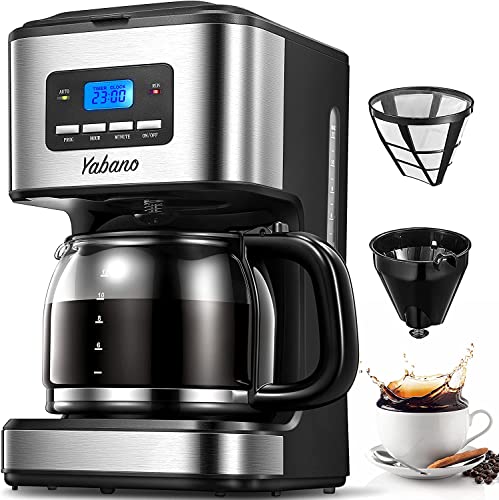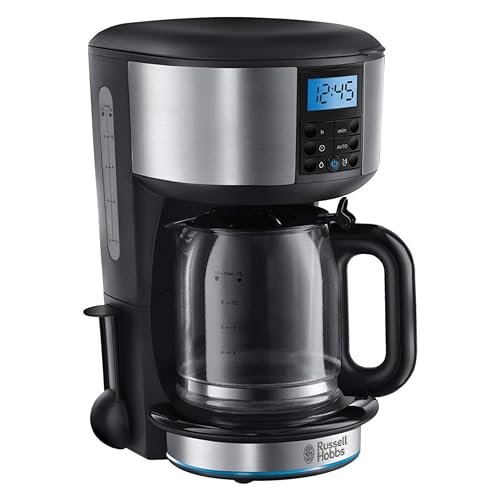What's The Job Market For Coffee Filter Machine Professionals Like?
페이지 정보
작성자 Aileen McClusky 댓글 0건 조회 19회 작성일 25-01-16 15:17본문
 The Importance of a Coffee Filter Machine
The Importance of a Coffee Filter MachineIt is recommended to use clean, fresh and filtered water to get the best results. This allows the complex flavors of coffee beans shine through.
 You can also save money in the long term by using a filter machine, as you only need to buy coffee filters and paper. You can also save money on cleaning costs and disposal.
You can also save money in the long term by using a filter machine, as you only need to buy coffee filters and paper. You can also save money on cleaning costs and disposal.Filtered Water
Many coffee and espresso machines come with a filter system. Others use reusable filters, like the one everyone loves, the Brita. Whichever method you decide to use the most crucial step in making the perfect cup is to use clean water. Aside from the obvious health benefits, drinking filtered water improves the flavor and consistency of your beverage.
The process of filtration works by forcing the water through a filter of tightly woven mesh or paper, which is either bleached or unbleached. Unbleached filters do not use chemicals, but are bleached with oxygen or chlorine to get their white color. Some people like the taste and smell of a cup of coffee made with a bleached or unbleached filter, while others find it harsher or less flavorful.
There are permanent coffee filter systems, including perforated metal sheets as well as fine plastic mesh. Porous ceramics and glazed porcelain sieves and porous ceramics can be used to keep the coffee grounds inside while allowing water flow through. They may need to be boiled or rinsed frequently to ensure they function however they are less expensive and less inefficient.
Filtered water also works well with pour-over and French press methods since it gets rid of some of the coffee oils that could taint the final cup. These oils are essential to the flavor and aroma of the coffee. Eliminating them can make an enormous difference. In addition to this filtering makes sure that all the ground coffee is properly brewed and does not leave any granules behind.
To get the best results, it is important to use the right filter for your brewing method. Aeropress is a good example. It uses a paper filter of a certain size to reduce the amount coffee oil and sludge in the final product. It is also crucial to wash the filter coffee machine with hot water prior every use, since it removes any remaining paper flavour and keeps the coffee from being soiled. In addition, some users find that conical filters make their coffee more smooth and richer than a traditional flat filter because it allows the water to flow uniformly through the grounds due to gravity.
Temperature and pressure
The temperature of the water in a coffee filter machine is vital. It is important to ensure that the water-to-coffee proportion is correct. The ideal temperature for brewing is between 88degC and 92degC. Some machines have built-in water thermometers which allow you to measure the temperature of the brew. Other gadgets, such as thermometers with goosenecks and infrared lasers can also assist you to attain the ideal temperature for your brewing.
The type of filter paper used in a coffee filter machine is another important factor. Paper filters are the most commonly used but reused filter sieves are becoming more popular. They are made from materials like woven metals (including aluminium, copper and steel) and plastics (including Makrolon/Exolon, Tritan, and Ecozen) as well as porous ceramics or porcelain, and can be placed in holders for filtering paper or cloth filters.
These filters are available in a wide range of sizes and shapes. Some of them have a distinct "paperish" taste, which can be diluted by washing the filter with hot water before use. Permeability can be a significant factor in the final taste of the coffee. This is affected by the size of the filter, its shape, the material that it is made from, and the method of manufacture.
It is crucial to regularly clean your filter coffee maker, especially when you reside in a region that has hard water. This will ensure that the machine is working efficiently and prevent mineral deposits. Regular cleaning routines should include emptying the used grounds and rinsing the filter basket.
Multiple studies have investigated the effects of different brew temperatures on total dissolved (TDS) and extraction quality. The results suggest that an excessive TDS and low extractive quality may result in unfavourable sensory characteristics, including bitterness, astringency, and the sourness. However, the data from these studies do not compare coffees served at temperatures that are controlled and, therefore, cannot determine whether the sourness that is observed is due to an increase in TDS or a lower extractive quality. Additionally, the astringency and bitterness that were observed in these tests could be attributed to other factors such as the grind size or the roasting level of the coffee.
Extraction
During the brewing procedure water extracts flavor compounds and oils that impart the desired flavor to a cup of coffee. This extraction is a variable process that is affected by many factors, such as the temperature of the water and brew duration, as well as the type of filter that is used.
The filter of the coffee must be soaked before making coffee to improve the flavor. It improves the aroma of coffee by ensuring an even extraction of coffee grounds and reduces bitterness through limiting excessive extraction of ground beans.
Pre-wetting the filter of coffee enhances the experience of brewing coffee by removing any taste of paper and preheating the brewing vessel, ensuring that it is at the right temperature for brewing. This ensures the coffee is evenly distributed, resulting in a more balanced and smoother cup of coffee.
Coffee filters come in a variety of shapes to accommodate various brewing equipment and methods. Some of the most popular are cone filters, basket filters and flat-bottom filters. The shape of the coffee filter has an immediate impact on the extraction. The choice of the coffee grounds, and the brewing temperature, also affects flavor.
It is essential to moisten the flavoured filter coffee with water prior to starting the brewing process, whether the coffee is brewed using a drip, an immersion or pour-over coffee maker. Wetting the coffee filter encourages the release of carbon dioxide and prevents the flavor of paper, which can negatively impact the coffee's flavor.
The filter will also be agitated, and the grounds of coffee are evenly distributed throughout the filter system. This helps to minimize over-extraction and achieve the same brew for each batch.
Pre-wetting can also aid in stabilizing the flow of water and ensure that the brewing area has been completely saturated. This reduces the chance of over-extraction, which can cause bitterness and astringent flavors in the final coffee.
The chemistry behind the optimum temperature for brewing is complex and varied, but for filter coffee machines, the recommended range is between 195degF to 205degF (90degC to 96degC). This is the ideal temperature for a wide range of brewing techniques and prevents areas of significant corrosion or scaling in the coffee maker's internal components.
Cleaning
A regular cleaning schedule is an essential aspect of maintaining a good coffee filter machine. This simple task can help prevent accumulation of hard water and the formation of a layer that could negatively affect the flavor of the coffee. This simple task can save you money over time by cutting down on the frequency of filter replacements.
For paper, cloth, and metal filters, the first step in cleaning the filter daily is to dump out any remaining dirt. Then, clean the filter on your own or in a sink filled with warm water. You can also soak the filter in a mixture of white vinegar and warm warm water to get a better clean. This will help to dissolve residues and oils. A little bit of baking soda can be used as a mild abrasive to scrub away stubborn stains and residue. Clean and dry your filter thoroughly before applying it to the next time.
Whether you have a drip pot coffee maker or a pour-over coffee maker, regular deep cleaning is essential to ensure an excellent cup of coffee each time. This will keep your coffee maker in top working order and minimize the possibility of mold or bacteria growth.
Check the user manual of your machine for cleaning guidelines. In the majority of cases, you can clean the reservoir of water with hot soapy water and remove any stains. Cafiza is a specific cleaning product that can be used to get rid of any remaining odors or buildups from your coffee maker.
This cleaning solution can also be used to clean the carafe in your machine or other removable parts such as the lid or plunger. To get the best drip coffee machine uk results, wash and dry your machine bean to cup filter coffee machine eliminate any vinegar scents or tastes.
A well-maintained coffee filter machine is an excellent investment for any household and will let you enjoy a better-tasting cup of coffee. If you take care of it, your Coffee Filter Machine (Https://Walters-Mcfadden-3.Technetbloggers.De/) will be an integral part of your morning routine for a long time. So, don't hesitate to make the leap and invest in a premium coffee maker today!
댓글목록
등록된 댓글이 없습니다.